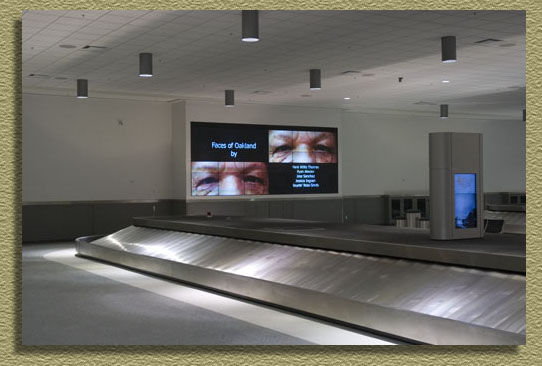 |
|||||||||
|
The Media Wall at Oakland’s International Airport
Background of the Project Port of Oakland and Its Public Art Ordinance Established in 1927, the Port of Oakland oversees the Oakland seaport, Oakland International Airport and 19 miles of waterfront. The seaport is the fourth busiest container port in the United States, Oakland International is the second fastest growing airport in the nation and the commercial real estate development at Jack London Square is Oakland’s premiere entertainment spot. The three revenue-producing divisions (Maritime, Aviation and Commercial Real Estate) are governed by a seven-member Board of Port Commissioners appointed by the mayor of Oakland. In May 2002, the Port of Oakland adopted a Public Art Ordinance as one way of addressing the responsibility for how its operations and actions impact the social fabric and population it serves. By providing the public with opportunities to experience high quality art of enduring value that reflects the diversity of the region and its people, the Ordinance reinforces the Port’s commitment to its customers, employees, the community and the environment. The Public Art Ordinance makes public art a requirement for all major construction projects and for private development on land purchased and leased from the Port. The Port is committed to commissioning a wide range of artistic styles, forms, media and disciplines that characterize the breadth of contributions an artist can make to the public arena. Oakland International Airport Renovation and Expansion To accommodate the growing air transportation needs of the San Francisco Bay Area and to further expand the value and convenience of Oakland International Airport, the Port of Oakland is expanding the passenger terminal facilities. These improvements will enable the airport to handle approximately 13.8 million passengers a year compared to 12.7 million in 2002 and 9 million passengers in 1999. Passenger traffic in 2010 is expected to be approximately 50% greater than current totals. The Terminal Expansion (TEx) Program is a phased program that includes the roadways to the airport, the renovation and expansion of the existing Terminal 2 and the future design of a new terminal. The present phase consists of the addition of a multi-level automobile parking garage, adjoining office building, improvements to the site such as new roadways and surface parking, seven new gates and the installation of new baggage and passenger security screening systems. Role of the Oakland Museum of California Through a competitive process, the Oakland Museum of California (OMCA) was chosen by the Port of Oakland to manage the public art program for the T2 renovation and expansion and for the new parking garage. Under a three-year contract with the Port, OMCA was responsible for overseeing the artist and artwork selection and approval processes, managing artist contract negotiations and monitoring the design, fabrication and installation of the artwork. To engage and educate the community, OMCA conducted public workshops and prepared educational and press materials for public distribution. The members of the Project Management Team are: Cherie Newell - Director, Oakland Museum Professional Services Gail M. Goldman, Public Art Director, Public Art South West Chris Johnson - Professor, CCA, Media Wall Project Manager Susan Pontious, Deputy Program Director, SF Public Art Program Kaoru Kitagawa, Exhibit Designer, Oakland Museum Professional Services Allyson Hollingsworth, Technical Specialist, Oakland Museum Professional Services Media Wall System The “canvas” for the display of these works is a video wall consisting of 18 - 53” CRT rear projection cubes (3 high x 6 across) creating an array that is roughly 20’ wide by 8’ high. The video processors for the Media Wall allows artists to create works that are either synchronized to create one large, animated image, encompassing the entire display area, or as two side by side (3 x 3) images arrays. Click to see a complete hardware narrative for the Media Wall Media Wall Site The renovation of Terminal 2 included the construction of a new baggage claim area for Southwest Airlines. Located at the east end of the existing Terminal 2, the new baggage claim area is occupied by 100-300 people at any given time throughout the day. Their average wait for luggage is 15-20 minutes. Arriving passengers enter the baggage claim area from the new and existing concourses and depart through the new baggage claim lobby onto street level. There are three luggage carousels with a distance of 25 feet between each. Each carousel has a flight display and advertising board located on the outer platform. The east wall of the bag claim building is the site of the Media Wall, which is approximately 70 feet from one end of the carousel and 11 feet from the end nearest the Media Wall. I would like to offer special thanks to all of the Project Management Team (listed above) for all their wonderful work in helping to make this possible. Also thanks to Chris Conte and Tom Brighton of Electrosonics for their engineering expertise and patience. |
|||||||||
|
|
|||||||||
|
|
|||||||||
